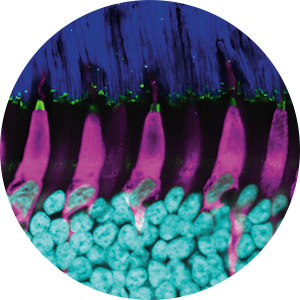A quest to save patients’ vision
Research and therapeutics
A decade after founding Usher 1F Collaborative, couple optimistic that treatment is in sight
The diagnosis of a rare genetic disorder for their two daughters thrust Elliot and Melissa Chaikof into a disheartening medical void. Faced with the grim reality that little research and virtually no therapies existed for Usher syndrome type 1F, which causes deafness at birth and progressive vision loss, the Chaikofs founded the Usher 1F Collaborative in 2013. Their mission: drive medical research toward a treatment to save or restore patients’ vision.
A decade later, nine groups at universities in the United States, Canada, and Australia are working on treatments for Usher 1F thanks to funding from the collaborative, which has united many other affected families in raising awareness and funding for this disease.

Usher 1F is a particularly severe form of Usher syndrome, which occurs when a gene mutation causes cells in the eye and ear to stop producing an essential protein. David Corey, PhD, the Bertarelli Professor of Translational Medical Science in the Blavatnik Institute at Harvard Medical School, had devoted decades to studying the normal function of the protein. It wasn’t until a conference organized by the Chaikofs in Boston in 2017 that Corey met their daughters and found a new motivation for his research, reinvigorating the family’s quest for a cure.
“Because David understood the gene so well, he basically leapfrogged ahead of where the research was and hit the ground running,” says Melissa Chaikof, chair of the Usher 1F Collaborative.
Since that conference, the Corey Lab—backed by funding from HMS and nearly $1 million from the Usher 1F Collaborative—has made considerable progress in developing three potential gene therapies for Usher 1F blindness. The lab first showed that the therapies could preserve hearing in the ears of mouse models, but they were not optimistic that treatments would work in human patients, who are born profoundly deaf and may have already lost the receptor cells in their inner ear. Conversely, their vision loss is gradual, providing an opportunity to intervene to preserve their sight.
“The project has been enormously complex because we’re testing three different strategies in two different organs and four different species,” Corey said. He and his collaborators hope that at least one therapy will safely stop and perhaps even reverse vision loss in patients with Usher 1F. Their development of a mini-gene therapy, which has shown the most promise so far, recently received a $1.2 million boost from the Foundation Fighting Blindness (see story at right).
“I would never have been able to get a major grant from the Foundation Fighting Blindness (FBB) without strong preliminary data showing that we know how to study the anatomy and physiology of the retina,” says Corey, whose lab is known for its research in hearing. “The seed money from Usher 1F Collaborative gave us the chance to do that, and as a result our application to the FFB was successful.”
Elliot Chaikof, MD, PhD, the Johnson and Johnson Professor of Surgery and head of the Department of Surgery at Beth Israel Deaconess Medical Center, says Corey has made remarkable progress in a very short period of time. “This is an outstanding example of how basic science can be translated to therapies.”